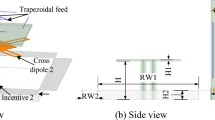Abstract
Spectrum sensing with multiple antennas for cognitive radio systems in microcell environments is affected by the spatial correlation among multiple antennas. To reduce the adverse effects of the spatial correlation on the spectrum sensing performance, we employ multiple dual polarization antennas at the sensing node of secondary users. The analysis of the spatial correlation is derived using the propagation characteristics of the electromagnetic wave based on the scattering patch model in a multipath microcell environment. The superiority of spectrum sensing with multiple dual polarized antennas over multiple mono-polarized antennas is shown by analyzing the false alarm and detection probabilities with the correlation among the antennas in a microcell environment.
Similar content being viewed by others
References
Akyildiz, I.F., Lee, W.Y., Vuran, M.C., Mohanty, S., 2006. Next generation/dynamic spectrum access/cognitive radio wireless networks: a survey. Comput. Netw., 50(13): 2127–2159. [doi:10.1016/j.comnet.2006.05.001]
Alouini, M.S., Abdi, A., Kaveh, M., 2001. Sum of gamma variates and performance of wireless communication systems over Nakagami-fading channels. IEEE Trans. Veh. Technol., 50(6):1471–1480. [doi:10.1109/25.966578]
FCC, 2002. Spectrum Policy Task Force Report. Proc. Federal Communication Commission, p.1–37.
IEEE 802.22 Working Group on Wireless Regional Area Networks, 2011. IEEE 802.22-2011(TM) Standard for Cognitive Wireless Regional Area Networks (RAN) for Operation in TV Bands. Available from http://grouper.ieee.org/groups/802/22/.
Kay, S.M., 1998. Fundamentals of Statistical Signal Processing, Volume II: Detection Theory. Prentice-Hall, Upper Saddle River, NJ.
Kim, S.T., Lee, J.M., Wang, H.N., Hong, D.S., 2009. Sensing performance of energy detector with correlated multiple antennas. IEEE Signal Process. Lett., 16(8):671–674. [doi:10.1109/LSP.2009.2021381]
Kuppusamy, V., Mahapatra, R., 2008. Primary User Detection in OFDM Based MIMO Cognitive Radio. 3rd Int. Conf. on Cognitive Radio Oriented Wireless Networks and Communications, p.1–5. [doi:10.1109/CROWNCOM.2008.4562561]
Lee, J.H., Baek, J.H., Hwang, S.H., 2008. Collaborative Spectrum Sensing Using Energy Detector in Multiple Antenna System. 10th Int. Conf. on Advanced Communication Technology, p.427–430. [doi:10.1109/ICACT.2008.4493794]
Liu, H.Y., Zhang, Y.R., 2008. An Outdoor Scattering Channel Model for Dual-Polarized MIMO Systems. 2nd Int. Symp. on Intelligent Information Technology Application, p.760–764. [doi:10.1109/IITA.2008.313]
Mitola, J., 1999. Cognitive radio: making software radio more personal. IEEE Pers. Commun., 6(4):13–18. [doi:10.1109/98.788210]
Mitola, J., 2000. Cognitive Radio: an Integrated Agent Architecture for Software Defined Radio. PhD Thesis, Royal Institute of Technology (KTH), Sweden.
Quan, Z., Chi, S., Sayed, A.H., 2008. Optimal linear cooperation for spectrum sensing in cognitive radio networks. IEEE J. Sel. Topics Signal Process., 2(1):28–40. [doi:10.1109/JSTSP.2007.914882]
Raoof, K., Prayongpun, N., 2005. Channel Capacity Performance for MIMO Polarized Diversity Systems. Int. Conf. on Wireless Communications, Networking and Mobile Computing, p.1–4. [doi:10.1109/WCNM.2005.1543970]
Ruck, G.T., Barrick, D.E., Stuart, W.D., Krichbaum, C.K., 1970. Radar Cross Section Handbook, Vol. II. Plenum, New York.
Svantesson, T., 2001a. Antennas and Propagation from a Signal Processing Perspective. PhD Thesis, Chalmers University of Technology, Goteborg, Sweden.
Svantesson, T., 2001b. A Physical MIMO Radio Channel Model for Multi-element Multi-polarized Antenna Systems. IEEE Vehicular Technology Conf., p.1083–1087. [doi:10.1109/VTC.2001.956941]
Tarng, J.H., Ju, K.M., 1999. A novel 3-D scattering model of 1.8-GHz radio propagation in microcellular urban environment. IEEE Trans. Electromagn. Compat., 41(2):100–106. [doi:10.1109/15.765097]
Tarng, J.H., Chang, W.R., Hsu, B.J., 1997. Three-dimensional modeling of 900-MHz and 2.44-GHz radio propagation in corridors. IEEE Trans. Veh. Technol., 46(2):519–527. [doi:10.1109/25.580790]
Xu, Y.H., Lim, M.S., 2012. Spectrum Sensing Using Dual Polarized Multiple Antennas in Cognitive Radio Systems. Asia-Pacific Conf. on Communications, p.914–917. [doi:10.1109/APCC.2012.6388241]
Author information
Authors and Affiliations
Corresponding author
Additional information
Project supported by the Brain Korea 21 Plus of Korea and the Ministry of Trade, Industry & Energy (MOTIE) and IDEC Platform Center (IPC) for Smart Car of Korea
A preliminary version was presented at the 18th Asia-Pacific Conference on Communications, October 15–17, 2012, Jeju Island, Korea
Rights and permissions
About this article
Cite this article
Xu, Yh., Lim, MS. Spectrum sensing using multiple dual polarization antennas for cognitive radio systems in microcell environments. J. Zhejiang Univ. - Sci. C 14, 792–798 (2013). https://doi.org/10.1631/jzus.C1300086
Received:
Accepted:
Published:
Issue Date:
DOI: https://doi.org/10.1631/jzus.C1300086




